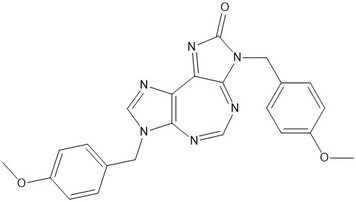RK-33 | DDX3 inhibitor
NMR (Conforms)

Available Options
| Size: | Price | Quantity | |
|---|---|---|---|
| 5 mg | $50.00 | ||
| 25 mg | $175.00 |
RK-33 (1070773-09-9) is an inhibitor of the RNA helicase DDX3 – IC50’s = 4.4-8.4 µM in high DDX3 expressing lung cancer cell lines A549, H1299, H23, and H460.1,2 Inhibition of DDX3 led to activation of cell death pathways, inhibition of Wnt pathway signaling, and abrogation of non-homologous end-joining (NHEJ) DNA repair. RK-33 was also active in colorectal cancer 3, prostate cancer4, and medulloblastoma cancer5 cell lines. RK-33 caused radiosensitization in breast cancer through inhibition of mitochondrial translation.6 RK-33 facilitates differentiation in human embryonic stem cells (hESC) and decreases pluripotency markers as well as reducing teratoma formation.7
References/Citations:
1) Kondaskar et al. (2011), Novel, Broad Spectrum Anticancer Agents Containing the Tricyclic 5:7:5-Fused Diimidazodiazepine Ring System; ACS Med. Chem. Lett., 2 252
2) Bol et al. (2015), Targeting DDX3 with a small molecule inhibitor for lung cancer therapy; EMBO Mol. Med., 7 648
3) Heerma van Voss et al. (2015), Identification of the DEAD box RNA helicase DDX3 as a therapeutic target in colorectal cancer; Oncotarget, 6 28312
4) Xie et al. (2016), RK-33 Radiosensitizes Prostate Cancer Cells by Blocking the RNA Helicase DDX3; Cancer Res., 76 6340
5) Tantravedi et al. (2019), Targeting DDX3 in Medulloblastoma Using the Small Molecule Inhibitor RK-33; Transl. Oncol., 12 96
6) Heerma van Voss et al. (2018), Targeting mitochondrial translation by inhibiting DDX3: a novel radiosensitization strategy for cancer treatment; Oncogene, 37 63
7) Kerr et al. (2019), Targeting RNA helicase DDX3 in stem cell maintenance and teratoma formation; Genes Cancer, 10 11
NMR (Conforms)
Safety Data Sheet:
Product Data Sheet:
Materials provided by Focus Biomolecules are for laboratory research use only and are not intended for human or veterinary applications. Please note that we do not sell to individuals and that all orders placed by non-research organizations will incur a $20 restocking/refund fee
RK-33 (1070773-09-9) is an inhibitor of the RNA helicase DDX3 – IC50’s = 4.4-8.4 µM in high DDX3 expressing lung cancer cell lines A549, H1299, H23, and H460.1,2 Inhibition of DDX3 led to activation of cell death pathways, inhibition of Wnt pathway signaling, and abrogation of non-homologous end-joining (NHEJ) DNA repair. RK-33 was also active in colorectal cancer 3, prostate cancer4, and medulloblastoma cancer5 cell lines. RK-33 caused radiosensitization in breast cancer through inhibition of mitochondrial translation.6 RK-33 facilitates differentiation in human embryonic stem cells (hESC) and decreases pluripotency markers as well as reducing teratoma formation.7
References/Citations:
1) Kondaskar et al. (2011), Novel, Broad Spectrum Anticancer Agents Containing the Tricyclic 5:7:5-Fused Diimidazodiazepine Ring System; ACS Med. Chem. Lett., 2 252
2) Bol et al. (2015), Targeting DDX3 with a small molecule inhibitor for lung cancer therapy; EMBO Mol. Med., 7 648
3) Heerma van Voss et al. (2015), Identification of the DEAD box RNA helicase DDX3 as a therapeutic target in colorectal cancer; Oncotarget, 6 28312
4) Xie et al. (2016), RK-33 Radiosensitizes Prostate Cancer Cells by Blocking the RNA Helicase DDX3; Cancer Res., 76 6340
5) Tantravedi et al. (2019), Targeting DDX3 in Medulloblastoma Using the Small Molecule Inhibitor RK-33; Transl. Oncol., 12 96
6) Heerma van Voss et al. (2018), Targeting mitochondrial translation by inhibiting DDX3: a novel radiosensitization strategy for cancer treatment; Oncogene, 37 63
7) Kerr et al. (2019), Targeting RNA helicase DDX3 in stem cell maintenance and teratoma formation; Genes Cancer, 10 11
Calculate the molar concentration, mass or volume in a solution.
Concentration × Volume × Molecular Weight = Mass
Focus Biomolecules • Plymouth Meeting, PA USA • 1-855-FOCUS21
Focus Biomolecules
Plymouth Meeting, PA USA
1-855-FOCUS21
Website Created by Advanta Advertising LLC.

